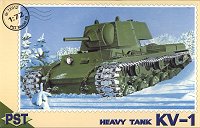
PST's Series of KV Heavy Tanks
Part 1
For many years, the only 1/72nd scale KV tank model was the old KV-1c from ESCI. Although this was an outstanding model, it has been out of production for many years, and is now rare. However, the Red Army fielded a large number of KV types, other than that single version. Thanks to the recent surge in interest in WW II Soviet tanks, the relatively new company of PST made a lot of modelers very happy with the release of almost every single version of this very important tank of WW II, including some very esoteric vehicles. After seeing the high quality of their earlier IS and ISU series of heavy tanks, I was optimistic that PST would also give us exceptional kits of the KV series, and they have done this admirably.
This article will be a combined preview of all of PST's KV tank kits, due to the similarity of the models. In fact, because of the inclusion of several optional parts, as well as the very minor differences between KV versions, some of the kits are identical, differing only in boxart. Many of the part sprues are common between all of the KV models, so I have sorted the following review to indicate which sprues are included with each kit, keeping repetition to a minimum. In this current article, I have only provided part scans for the PST kits. In a later article, I will present and discuss all available KV kits, conversions, and accessories in 1/72nd scale.
The KV heavy tank came in several different flavors. The initial prototype was well ahead of its time, as far as armor protection and weaponry were concerned, although it was hampered by mechanical difficulties. As the war progressed, improvements and changes were made to both armor and firepower (as well as drive train upgrades, which will not be visible on our scale models). I have presented the kits in approximately chronological order, and very briefly describe the differences of each type from the previous versions.

The KV-1 is also known as the KV-1 Model 1939, and saw very brief service in the Winter War with Finland, as well as the early stages of World War II. This was the initial production version, armed with the L-11 76.2mm main gun, which was the same weapon used on the earliest version of the T-34 as well. There was no machinegun mounted in the front hull of the early examples, and the gun mantlet is very distinctive. Later tanks had the hull machinegun added, and this kit allows you to build either.
With this kit, I will introduce most of the basic parts for all the succeeding KV models.
The hull top is the first of four hull styles currently provided by PST, and represents the earliest variety. Overall, the piece is very well done, with excellent molding, detail and accuracy. The engine intake grates have a very good mesh pattern molded into them, although they would look better yet replaced with etched brass. Notice the bolt detail and panel lines on the engine deck. Some deficiencies include the closed crew and engine access hatches, and the lack of detail along the fenders. When this kit was first released, I saw that the hull on the old ESCI kit was much better detailed than this one (although of a later version of the tank), but PST has since improved the detail on the later hull styles, as will be seen further on.
The above sprue shows most of the miscellaneous details that come with each and every KV kit. It includes spare fuel cannisters, fender stowage bins, tow hooks and rings, the end-loops for the tow cables (which need to be manufactured by the modeler), as well as numerous smaller details.
The lower hull and wheel sprue is mostly identical through all of the following kits, but with the road wheels occasionally changing as appropriate. The idler and sprocket wheels are very detailed, with two types of hub cap for the sprocket wheel (early and late). The return rollers are likewise well done:

The sprue included in this kit has the earliest style of road wheel, which is pictured below in detail:
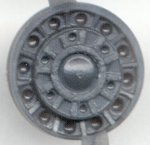
As you can see, the wheel is very detailed, and accurately reproduced, but many of the wheels are molded off-center, with the rims varying in thickness around the circumference of the wheel. Some careful sanding can reduce the problem somewhat, but it may still be noticeable on the finished model, if one knows what to look for.

The chassis looks very good, but the mounting arms for the road wheels are a little heavy, and if viewed without the wheels on the tank, they may need to be carved a little bit, to take the backs off of them. The reason they are too thick was in order to mold them onto the hull sides, instead of as separate parts. But they won't be noticeable if the model is built with a complete set of wheels and tracks.
Speaking of tracks, they are hard plastic, link-and-length, and for the most part are pretty well detailed. They are not quite as finely detailed as some of the newest Revell tracks, but they are certainly well done and good enough to use.
The final sprue included in this kit is the turret sprue. This sprue is common to many of the following kits, and it includes all the optional parts (primarily gun mantlets and armor) to build several versions of the KV-1. Most of the parts are add-on armor plates for use in the later KV-1E kit, and three versions of gun mantlet, but for this current kit, there are actually very few turret parts used.
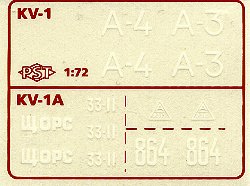
The decals are fairly simple, with this sheet covering both the KV-1 and the following KV-1A kit. For this scan, and all the following decal scans, please note that I have altered the contrast and brightness of the images in order to better show the white markings. In all cases, these decals are very good, and in fact, are some of the best kit decals I have ever used. They are very thin and crisply printed. With proper use of a decal setting solution, and a clear flat coat, the decal film completely disappears. Although this particular sheet has few options, keep in mind that in the early stages of the war, Soviet tanks carried few, if any, markings.
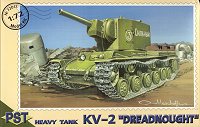
At about the same time that the KV-1 was entering service, so was the infantry support version, called the KV-2. The KV-2 Model 1939 underwent trials during the Winter War with Finland, and due to its performance, some minor changes were made. The most apparent of these was a redesigned turret, which is now referred to as the KV-2 Model 1940, and is the subject of this kit. This version saw action during the early stage of World War II.
This kit is essentially the same as the KV-1, but with a new turret sprue replacing the KV-1 turret sprue. All other parts are the same as the preceeding kit.
Once again, the turret is very well done. The commander's hatch is open, but although there is no opening for the rear loading hatch, the hatch door is molded as a separate part, so that the modeler can cut an opening for the hatch, in order to pose it in the open position (turret interior detail would need to be added).
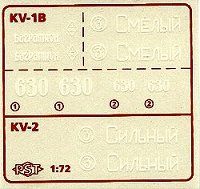
The decals are shared between this kit and the KV-1B, and give only one marking option for this tank.
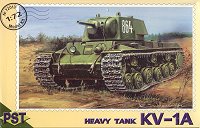
This version is also known as the KV-1 Model 1940, and has a few subtle changes from the earlier KV-1. The most obvious of which, is the change from the 76.2mm L-11 cannon to the F-32 cannon of the same calibre. For this kit, the difference is reflected in using a different gun mantlet and gun barrel. There is also the addition of the front hull machinegun, and armor strips along the turret race.
This kit is identical to the KV-1 kit, including the decal sheet, with the only differences obviously being the boxart and the instruction sheet.
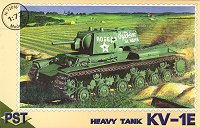
Due to an incorrect assessment of German anti-tank capabilities, there was an effort to uparmor the KV-1 to provide more protection. The solution was to bolt applique armor plates to the turret and hull sides. Although greatly increasing the protection, the additional weight was troublesome, and as it turned out, unnecessary. The result was known as the KV-1E, or "KV-1 Applique Armor".
This kit is identical to the KV-1A kit, but with a new decal sheet, providing a couple of marking options.
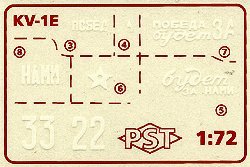
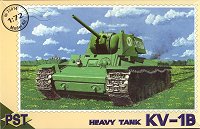
The KV-1B is also called the KV-1 Model 1941. Again, the main difference is a change of the primary armament from the F-32, to the Zis-5, which is essentially the same gun as the F-34 used on the later T-34 variants. Also again, the difference in the building of this kit is the use of a new gun mantlet and barrel.
The model is identical to the previous KV-1's, with a new box and instructions. The decals are the same as with the KV-2 kit.

The KV-8 was a flamethrower version of the KV-1. The gun mantlet was changed to incorporate the flame nozzle (replacing the co-axial machinegun) and a smaller main gun (45mm) in place of the 76.2mm. A sleeve was fitted over the 45mm gun barrel, in order to make it appear larger, and not draw undue attention from enemy anti-tank gunners.
This kit is the same as the earlier KV-1 kits, with new decals. Note that the boxart shows the tank with the later style road wheels, which is deceiving; the kit actually contains the same wheels as the earlier KV's. But this is not to say that the box is historically inaccurate. I imagine that this vehicle could have probably been seen with both wheel styles, but be aware that only the early style is included in the kit.

| Back to PST Kit List | Back to Home Page |